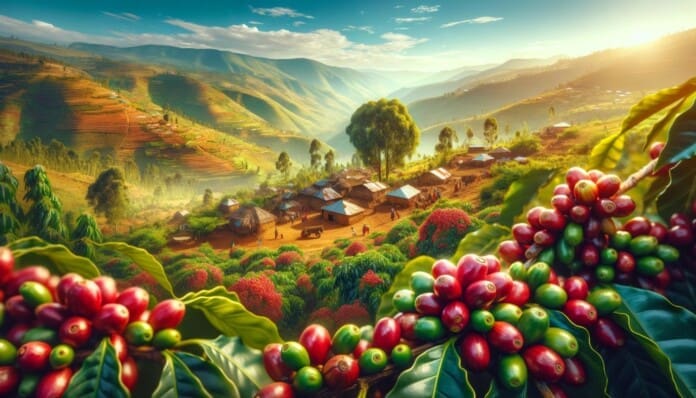Ethiopia, a country synonymous with rich coffee heritage, offers a diverse palette of flavours and aromas through its coffee varieties. Hambella and Yirgacheffe stand out as two of the most distinguished types. This article aims to delve into the nuances of these varieties, offering coffee enthusiasts a guide to understanding and appreciating their unique characteristics.
Hambella: The Hidden Gem
Nestled in the lush landscapes of Ethiopia, Hambella is a variety that is gaining attention for its unique flavour profile. The region’s geographical conditions and specific climate are crucial in shaping the beans’ distinct taste. Hambella coffee is known for its bright acidity and complex berry notes, offering a refreshingly unique experience to the palate.
Yirgacheffe: A World-renowned Variety
Yirgacheffe, on the other hand, has long been a favourite among coffee connoisseurs. Its cultivation in the fertile Yirgacheffe region imparts a floral and aromatic flavour profile. The coffee is often characterized by its light body and vibrant acidity, complemented by a subtle sweetness reminiscent of citrus and jasmine.
Comparative Analysis: Hambella vs Yirgacheffe
Comparing these two varieties reveals distinct differences in cultivation methods, flavour profiles, and environmental impacts. Hambella beans have a fuller body and a more pronounced berry flavour, while Yirgacheffe offers a more delicate, floral essence. The cultivation practices in both regions also reflect the commitment to sustainability and ethical farming.
Consumer Preferences and Market Trends
The global coffee market has shown an increasing interest in both Hambella and Yirgacheffe varieties. This demand has significant implications for local Ethiopian communities, affecting everything from economic growth to cultural practices. Understanding these trends helps in appreciating the broader impact of our coffee choices.
Brewing the Perfect Cup: Hambella and Yirgacheffe
Specific brewing techniques are recommended to enjoy the distinct qualities of Hambella and Yirgacheffe fully. For Hambella, a method that highlights its bold flavours, like the French Press, is ideal. In contrast, Yirgacheffe’s delicate notes are best enjoyed through a pour-over method. Pairing these coffees with the right foods can further enhance the tasting experience.
Sustainable Practices in Coffee Production
In both Hambella and Yirgacheffe regions, sustainable coffee production is a practice and a way of life. Ethical sourcing and fair trade initiatives ensure that the farmers receive a reasonable price for their beans while also focusing on environmental sustainability. These practices help preserve Ethiopia’s natural beauty and resources, ensuring that coffee production benefits the land and its people.
The Health Benefits of Coffee: Hambella and Yirgacheffe
Beyond its stimulating effects, coffee offers various health benefits. Both Hambella and Yirgacheffe varieties are rich in antioxidants, contributing to overall health. However, it’s essential to debunk myths about coffee consumption and understand its actual impact on our well-being. Moderation is key, as is the case with any dietary choice.
The Impact of Climate Change on Coffee Production
Climate change poses a significant threat to coffee production worldwide, and Ethiopian varieties like Hambella and Yirgacheffe are no exception. Farmers are adopting innovative adaptation strategies to cope with changing weather patterns. The resilience of these communities is a testament to their dedication to preserving the legacy of Ethiopian coffee.
Exploring the Future of Ethiopian Coffee Varieties
The future of Ethiopian coffee, including varieties like Hambella and Yirgacheffe, looks promising. Innovations in farming and processing techniques continue to evolve, adapting to global challenges and market demands. As we look to the future, the global perspective on Ethiopian coffee remains one of excitement and anticipation.
The journey through the flavours and stories of Hambella and Yirgacheffe coffees is not just about tasting two exceptional varieties. It’s about understanding their cultural significance, appreciating the sustainable practices behind their production, and recognizing their impact on the communities that cultivate them. As we enjoy these remarkable coffees, let’s remember Ethiopian coffee culture’s rich heritage and enduring spirit.
FAQs: Common Queries about Hambella and Yirgacheffe
What makes Hambella coffee unique in its flavour profile?
Hambella coffee is cherished for its full-bodied flavour, bright acidity, and berry notes, distinct from other varieties.
How does the cultivation of Yirgacheffe differ from other coffees?
Yirgacheffe coffee is grown in a region known for its fertile soil and ideal climate, contributing to its unique floral and citrusy flavour profile.
Can the brewing method affect the taste of these coffees?
Absolutely! The brewing method plays a crucial role in extracting the unique flavours of Hambella and Yirgacheffe. Each variety may require a different approach to highlight its distinct characteristics.
Are Hambella and Yirgacheffe coffees sustainable choices?
Both varieties are often produced following sustainable farming practices, focusing on ethical sourcing and environmental conservation.
How do Hambella and Yirgacheffe coffees contribute to Ethiopian communities?
The production and export of these coffees provide significant economic benefits to local communities, supporting livelihoods and traditional practices.
Is there a significant difference in the caffeine content between Hambella and Yirgacheffe?
The caffeine content in both varieties is relatively similar, with slight variations that are generally not significant for the average consumer.


















